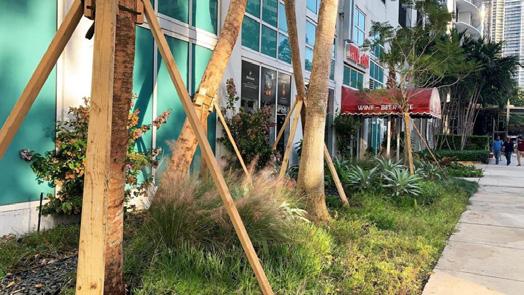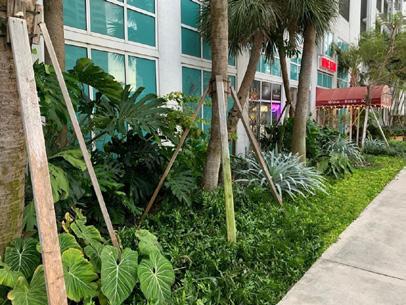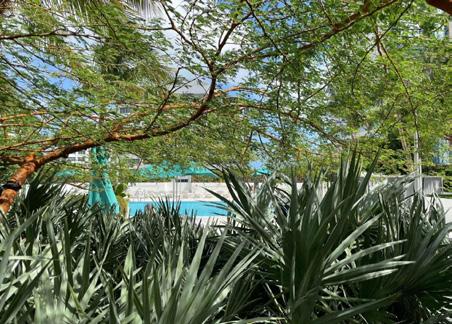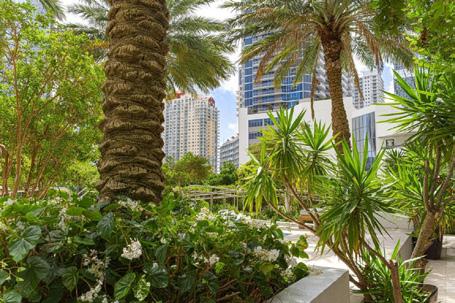
4 minute read
Beyond Curating Experiential Landscapes: Designing for Resilience
from July 2023
By: Architect Rituparna Simlai

Advertisement
In September 2017, Hurricane Irma slammed the coast of South Florida, after battering the Bahamas causing major devastation. The unprecedented impact of the disaster underscored our lack of preparedness and our choices to live in hurricane-prone areas without taking adequate precautions. It was a powerful example illustrating Benjamin Franklin’s words, “By failing to prepare you are preparing to fail”.
Natural disasters like Irma not only impact infrastructure and housing but also wreak havoc on natural ecosystems, such as coastal forests, mangrove swamps, hardwood hammocks, and forested wetlands. These ecosystems face significant damage from hurricane winds, uprooting trees and stripping verdure. Despite their resilience, these coastal forests serve the vital purpose of acting as physical barriers that reduce the impact of strong winds and storm surges.
One remarkable example of how even man-made ecosystems can enhance storm resistance is evident in Naluvedapathy, Tamil Nadu. When it didn’t rain in the region for a long stretch of time in 2002, a family in the village planted 80,000 trees along the river banks to invoke the rain gods. This set a Guinness World Record for the largest tree planting done in 24 hours. When the Tsunami devoured the coastal plains of the Indian subcontinent in 2004, this was one of the few villages that sustained minimal damage, due to the wall of trees.
Natural disasters serve as wake-up calls, urging us to honor the sacredness and supremacy of nature. All native cultures around the world acknowledged the dominion of nature, and they honored its existence. In the Anthropocene Epoch, these events prompt us to analyze our actions and design interventions that impact the environment. While we cannot prevent disasters, we can take measures at varying scales to mitigate their destructive impact on local populations and ecosystems. Every disaster presents an opportunity for renewal and new beginnings that are more grounded.
Reviving the landscape of Plaza on Brickell after Hurricane Irma



The Plaza on Brickell, a residential complex along the bayfront in Miami, saw a trail of devastation due to Hurricane Irma, where a majority of its landscape and once-thriving garden areas were in ruins. The towering palms that once graced the landscape were felled, and some even uprooted. Initially, the board members and contractors planned to replant the pool deck with smaller versions of the same species, despite their unsuitability for the region. This project was estimated to cost a staggering $200,000, perpetuating the same mistake.


As a resident of the area, I was naturally unhappy with the direction the project was taking. With my passion for planting, and experience as a landscape architect, I volunteered with the management to redesign the property’s landscape.
Working together with residents, contractors and the local nurseries, a conscientiously articulated planting plan with wind tolerant species was developed. By removing certain sections of the sidewalk and hardscape areas surrounding the building complex, we expanded the planting areas to allow stormwater infiltration, reducing runoff. Along the sidewalks,the addition of more green spaces and meandering paths nestled along palm trunks created charming gathering spots.
Amidst the concrete building setting, we integrated edible berries and flowering species that acted as a haven for butterflies, bees, and hummingbirds, creating small hubs of biodiverse activity. Whenever possible, native specimen trees took center stage, blending harmoniously with the local soil and climate. They allowed us to minimize the need for excessive fertilizers, pesticides, and irrigation, as these resilient species established themselves naturally, ensuring long-term stability. These indigenous species infused the design with a distinct sense of local character, contributing to the city’s identity.
Responding to the local climate and the hurricaneprone environment, we strategically introduced trees that could withstand high winds, offering minimal resistance to the flow. These trees typically have smaller leaf structures that shed quickly, and in some cases, they might lose a limb or branch to avoid being uprooted or sustaining severe damage to the main trunk. To honor the existing palm trees that survived the aftermath we cladded their trunks with flowering native orchids. Today, the Plaza on Brickell is a vibrant and thriving urban refuge with strategically located social nodes, complemented by a tranquil planting palette.
Rooted in the concept that every disaster offers an opportunity for new beginnings, the project taught us a valuable lesson: Responsible design is designing a resilient landscape that is not just for mere survival in the future but also allows for a steady recovery after an aftermath. It is to establish a purpose of design beyond functionality or aesthetics or physically uniting fragmented spaces. True design happens in the womb of sacredness. Our purpose is to understand and enhance the prevailing energy of the place- the genius loci or the inspiring force. With this immense learning, the project became the stepping stone for the inception of my own design practice, Studio Arth, which is built on the foundation to design with a purpose.
Curating social nodes and immersive landscapes

Along with planting for resilience, landscape design must also beckon visitors on a journey of discovery, offering a dynamic, spiritual experience. Creating immersive and socially engaging landscapes in public places requires a deep appreciation for the organic nature of plant life. The key lies in employing meticulous framing techniques to guide users’ views, skillfully blending varying heights, backdrops, elements, and water bodies. Harmoniously fusing textures, visuals, scents, and the natural elements of trees, earth, water and light enriches the design process, resulting in a truly unique and mesmerizing landscape encounter.



Transforming open spaces into landscaped urban oases demands a harmonious blend of artistry, sustainability, and contextual understanding. By curating immersive landscapes that complement surrounding architecture and cater to the needs of both the community and local biodiversity, landscape designers have the power to rejuvenate damaged areas, creating vibrant and inclusive environments for all.
The journey of recovery, rejuvenation, and impact requires time and patience. As Mark Twain humorously noted, everyone complains about the weather, but few take action. Living in disaster-prone areas transcends landscape design; it necessitates heightened awareness and preparedness within local communities. Responsible design involves taking ownership of our surroundings, adapting to nature’s rhythms, and cycles and being in sync with our surroundings. It means preparing for disasters rather than blaming authorities or the environment. Beyond aesthetics and functionality, landscape designers have the opportunity to create designs with a greater purpose, ones that are resilient and allow the local communities and biodiversity to thrive.











